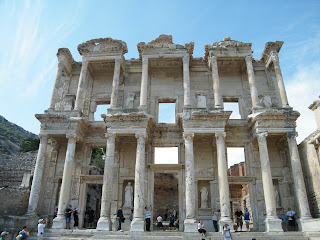During this week celebration I had the opportunity to visit Izmir, a wonderful and modern city located on the Aegean coast that beautifully shows its Hellenistic and early Roman past in the nice "agora" across the Jewish market. Differently from Istanbul, Izmir does not show a pronounced Islamic and Christian architectural outlook; however, similarly to the old Constantinople, it embodies the fluid identity of port cities, spaces that historically opened to trade and exchange were embedded of multicultural interconnections.
I later traveled to Seljuk, a nice small city outside Izmir and an excellent location to reach two amazing old Greek and Roman sites. First I went to Ephesus which contains what was the third largest library in ancient civilization after Alexandria and Pergamon, along with a well preserved archeological area whose Greek legacy, magnificence, and impressive architectural genius is simply breathtaking. From there it was easy to reach something surprising, the last house where the Virgin Mary lived after escaping from Jerusalem, today place of veneration and mass Christian pilgrimage every 15th of August.

The jovial and peaceful atmosphere that surround such a holy place located within the borders of an Islamic state seems to invite the visitor to rethink the universal and unifying rather than dividing appeal of religion in its multiple forms and expressions. After this visit, I explored Pamukkale and its terraces immersed into natural hot springs. Such area, extending from the wonderful ancient theater to the massive sixth century Christian basilica hosted the ancient ruins of the Greek-Roman city of Hierapolis, another example of the lasting legacy of the classic civilizations.
Afterwards, I slowly made my way back toward Malatya. First, I stopped in Fethiye, a beautiful and small touristic city. The sea is simply gorgeous and there are multiple cruises you can take to explore the Mediterranean. At the same time, you can also run into the incredible massive Lycian rock tombs dating back to the period prior to Alexander the Great, an outstanding example of ancient architecture which features the centrality of the ancient practice of burying.
Unfortunately, the weather was unusually ugly and because of that I decided to take a trip to Kayakoy, a ghost city located about 30 minutes from Fethiye. It was the best idea I could ever have. This city serves nowadays as a historical museum and was largely abandoned after the Greek-Turkish war of 1923 and its following people exchange agreement. It vividly embodies the legacy of WWI and the downsides of the principle of self-determination when forced upon communities that for long time peacefully lived in bordering states. The earthquake of 1957 almost completely destroyed the village and what is left is a few hundred houses and the Greek orthodox Church to remind us of its Greek past. From the top of the little church you can admire the sea, somehow accessible by walking through the bushes and following some red signals on the rocks.
After this brief trip to explore the ghost village, I began my 26 hours bus ride to return Malatya. Bus in Turkey are excellent and very cheap as compared to any other means of transportation; however, trips are generally long and roads are not made for a fast ride. Anyway, the exploration of the Aegean coast was worth the long hours in bus! People were very friendly as usual, night life was like that of any big summer tourist place in Europe and food was simply fantastic. So, after visiting the western and western southern coast of the country is now time to move north and south east to explore another side of this wonderful nation!















.JPG)
.JPG)


